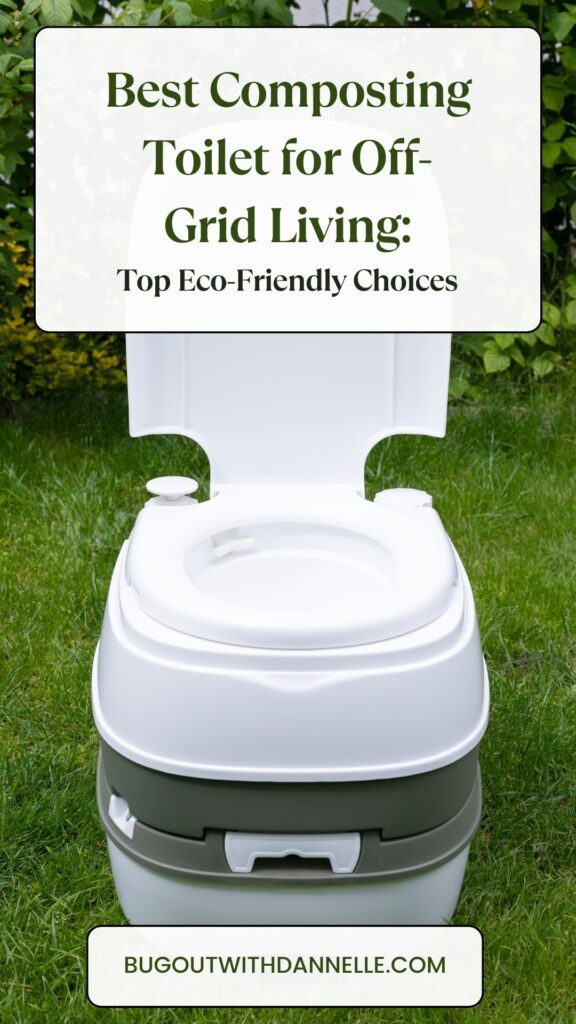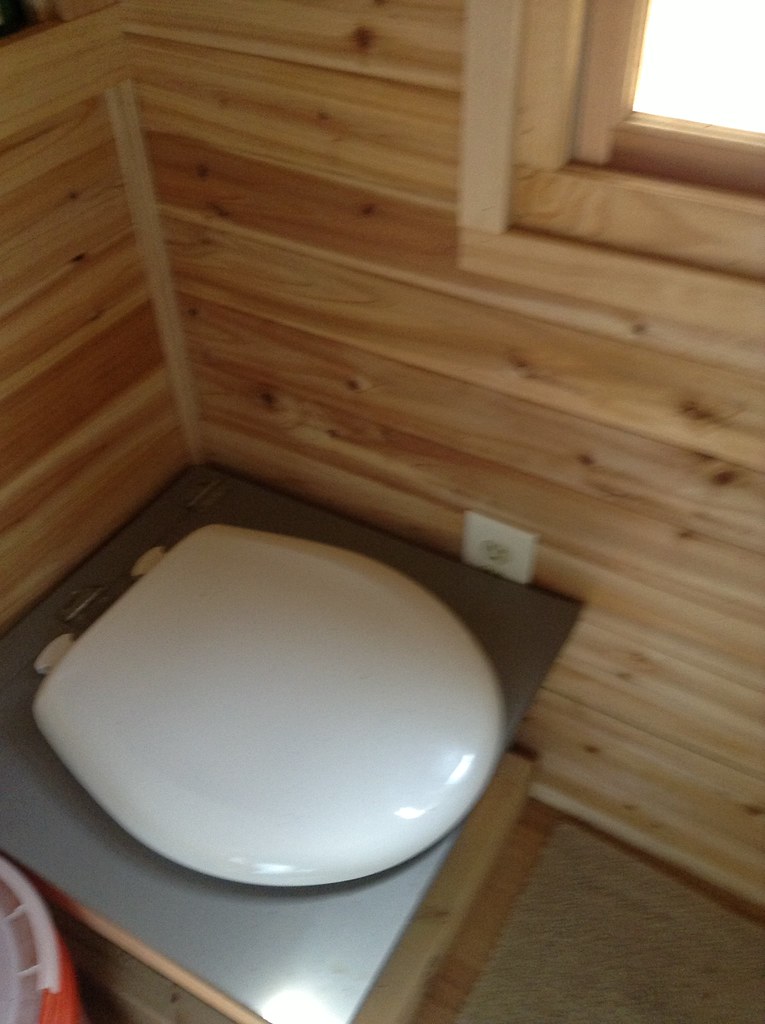When embracing an off-grid lifestyle, managing waste sustainably is crucial, and choosing the right composting toilet can make all the difference. These environmentally-friendly units are designed to turn human waste into compost, a nutrient-rich material that can benefit soil. They reduce the need for water and sewer connections, proving to be an ideal solution for remote cabins, RVs, or homes that strive for sustainability.

Understanding the various types and the best composting toilet for off-grid living is key. Some models separate liquid and solid waste to better manage odor and composting efficiency, while others may be more compact for use in tight spaces. Factors like ease of installation, capacity, and how easily the toilet can be cleaned should also influence your decision.
Considering options such as the Camco Portable Toilet can offer a lightweight and portable solution, making it perfect for camping or small off-grid homes.
Meanwhile, options like Nature’s Head Self-Contained Composting Toilet provide a more permanent fixture for those looking to invest long-term in their off-grid setup.
The right composting toilet for you will balance convenience, environmental impact, and ease of use to ensure your off-grid experience remains as comfortable as it is sustainable.
Benefits of Composting Toilets for Off-Grid Living
Composting toilets offer several advantages for off-grid living environments including the following.
Water Conservation: By nature, composting toilets are waterless. This is particularly beneficial when you live off-grid, as access to water can be limited. By using a composting toilet, you save a significant amount of water that would otherwise be used for flushing.
Reduction of Waste: Composting toilets turn human waste into compost through a natural decomposition process. You contribute to reducing the waste that would typically be sent to sewage treatment plants or septic systems.
Nutrient-Rich Soil: The byproduct of a composting toilet is nutrient-rich compost which is a benefit to your garden. However, you must ensure it is safely and properly handled according to health standards.
Odorless: When managed correctly, composting toilets are surprisingly odorless. Models like the Separett Villa 9215 include an electric venting fan to ensure any odors are eliminated.
Portability: Many composting toilets are portable. You can easily relocate them, making them ideal for remote living or mobile housing such as RVs, indicated by various models like those found on Outdoor Happens.
Ease of Use: Despite their different functionality from traditional toilets, composting toilets like the Separett Composting Toilet are easy to use, and they function similarly to conventional toilets, making them user-friendly for guests or new users.
Energy Conservation: Some composting toilets operate without electricity, such as the Nature’s Head composting toilet, making them ideal if you have no off-grid power sources.
Factors to Consider When Choosing the Best Composting Toilet for Off-Grid Living
When selecting a composting toilet for off-grid living, there are several key factors you should take into account to ensure you make an informed decision.

Size and Capacity: Consider how many people will be using the toilet and how frequently. A larger capacity means less frequent emptying.
Ventilation: Proper ventilation helps control odor and moisture. Look for models with built-in fans or venting systems.
Ease of Use: Your composting toilet should be user-friendly. The simple design might mean easier maintenance.
Materials and Durability: High-quality materials such as stainless steel or sturdy plastics promise longevity and ease of cleaning.
Power Source: Some composting toilets require electric power to operate fans and agitators. Assess your power availability.
Portability: If you need to move your toilet, consider a lightweight and portable design.
Eco-Friendliness: Your composting toilet should support a sustainable lifestyle by minimizing water use and efficiently converting waste into compost.
Local Regulations: Be aware of local sanitation regulations that may impact your composting toilet setup.
For an in-depth look, these composting toilets for off-grid living might give you a good starting point on how to pick one that suits your needs. Additionally, exploring portable composting toilets could provide insights if you’re inclined towards a more mobile solution.
Top Composting Toilet Models for Off-Grid Use
When considering a move to off-grid living, selecting an appropriate composting toilet is crucial for managing waste sustainably. Here’s a look at the top models suited for different off-grid scenarios.
Self-Contained Units
Separett Villa 9215: A leading choice for those seeking convenience and efficiency. Its electric venting fan eliminates odors and can be powered by either a 110V or a 12V system, making it versatile for homes and mobile living spaces. It’s lightweight and portable, weighing only 34 pounds.
Centralized Systems
Centralized Composting Toilets: These function as the cornerstone of a comprehensive waste management system and resemble a regular toilet. They feature a large holding tank often situated below the bathroom, ideal for families residing off-grid full-time.
Portable Solutions
Nature’s Head Composting Toilet: Tailor-made for situations where off-grid power sources are not available. This model is designed with portability in mind – perfect for RVs and boats. It has gained significant recognition for its ease of use without the need for external power.
Installation Process and Requirements
When installing a composting toilet for off-grid living, your first consideration is choosing the right model to fit your space and lifestyle needs. Selecting a composting toilet that accommodates the number of users and frequency of use is crucial.
- Location: Choose a dry area with enough space for the unit and proper ventilation.
- Ventilation: Ensure continuous airflow. Some models like the Separett Villa 9215 include an electric venting fan to aid this process.
- Power Supply: Check if your model requires an electrical connection for a fan or heater and ensure you have the right setup, such as a 110V or a 12V system.
Follow These Steps

- Read the Manufacturer’s Manual: Understand specific requirements including placement, power, and ventilation.
- Prepare the Area: Guarantee the floor is level and the space complies with the specifications.
- Install Vent Pipe: Position it correctly for efficient odor control.
- Secure the Unit: Fasten the toilet to the floor as directed.
- Connect Vent Fan: If applicable, wire the electrical components safely.
- Test: Before use, check all connections and ensure the toilet is functioning properly.
Proper installation not only ensures functionality but also promotes a hygienic and comfortable living space. Be sure to adhere to all specifications and consider assistance from a professional if necessary.
Maintenance and Use Guidelines
When selecting a composting toilet for off-grid living, understanding the maintenance and use protocols is essential for a healthy and odor-free environment.
The Separett Villa 9215 is an example of a toilet designed for ease of use and minimal maintenance. It includes an electric venting fan to mitigate odors and can be used with 110V and 12V power systems.
Here are key guidelines for maintaining your composting toilet.
- Ventilation: Ensure proper ventilation to prevent odors. The electric venting fan should be operational if your model includes one.
- Balance: Maintain a good balance between “greens” (nitrogen-rich waste) and “browns” (carbon-rich materials like sawdust) to aid decomposition.
- Emptying: Regularly empty the solid waste container according to the manufacturer’s guidelines. For the Separett Villa 9215, follow brand-specific instructions.
- Cleaning: Clean the toilet regularly to prevent bacterial build-up. Use natural cleaners to avoid harming the composting process.
Your composting toilet’s liquid waste should be managed separately.
- Liquids: Empty the urine container frequently to minimize odors. Dilute it and use it as a nitrogen-rich fertilizer if local regulations allow.
Finally, proper usage of your composting toilet ensures longevity and hygiene:
- Use and Educate: Make sure all users are familiar with the correct use of the composting toilet. Simple instructions posted near the toilet can help guests.
Remember to always adhere to your local regulations when disposing of waste. For more detailed information and specific models like the Separett Villa 9215, visiting the manufacturer’s website provides valuable insights and instructions.
Environmental Impact Assessment
When you consider a composting toilet for your off-grid living, you’re participating in a sustainable practice that has a significant positive environmental impact.
Composting toilets reduce water usage, as they do not require water for flushing. This is especially beneficial in areas where water conservation is crucial.
Decreased Water Consumption: Composting toilets save thousands of gallons of water per year, compared to traditional toilets, by eliminating the need to flush.
Nutrient Recycling: By converting human waste into compost, these toilets transform potential pollutants into beneficial soil additives, returning nutrients to the earth.
Reduced Waste: Composting toilets lessen the burden on sewage systems and decrease the volume of waste transported to treatment facilities.
| Benefit | Impact |
|---|---|
| Water Conservation | High |
| Nutrient Recycling | Moderate-High |
| Waste Reduction | High |
- Chemical Avoidance: You avoid the need for harsh chemicals often used in sewage treatment processes.
It’s important to maintain and operate your composting toilet correctly to fully realize these environmental benefits. Inappropriate use can lead to negative impacts such as odor and potential pathogen spread. However, following proper maintenance procedures ensures that your composting toilet remains an eco-friendly option.
Compliance with Local Regulations and Standards
When considering the installation of a composting toilet for off-grid living, you must comply with local regulations and standards. This ensures your setup is legal and safe. The requirements can vary significantly from one location to another, so doing your homework is essential.
Check With Local Authorities
- Health Board: Your first step should be to contact your local health department to learn about relevant health codes and permits.
- Plumbing Board: Some areas require approval from the plumbing board, as your composting toilet may need to meet specific plumbing standards.
Types of Permits Required:

- Installation Permit: You might need a permit for the initial installation of a composting toilet.
- Use Permit: Additional permits could be needed for ongoing use, depending on your jurisdiction’s guidelines.
Regulatory Considerations
- Size and Type: Certain states may have regulations regarding the size and type of composting toilets that are permissible.
- Maintenance Protocols: There may also be mandates on how you maintain and manage waste from your composting toilet.
Adhering to Local Codes
Installing a composting toilet that does not comply with local codes could result in fines or require you to remove the system.
Learn from Others
Talking with residents who already use composting toilets can also offer insights about compliance with state-specific regulations, such as those in Massachusetts or Colorado.
Be sure your composting toilet choice and usage align with all applicable rules to ensure your off-grid living remains hassle-free and lawful.
User Reviews and Experience
When selecting the best composting toilet for off-grid living, your fellow users’ experiences can be invaluable. Numerous customers have praised the Separett Villa 9215, citing its odorless operation with an electric venting fan—a vital feature for indoor use.
Its ease of installation and lightweight design also stand out, making it a top contender for both homes and mobile setups like RVs.
The Nature’s Head Self-Contained Composting Toilet receives accolades for its simplicity and efficacy. Users often remark on its good value and efficient waste separation, which ensures minimal maintenance. Its durability is regularly highlighted by off-gridders who demand reliability.
For those of you prioritizing portability and minimal setup, the Sun-Mar GTG Portable Electric Waterless Toilet is a frequently recommended option. User feedback frequently mentions its compact size and ease of installation, making it a go-to for short-term stays and those on the move.
Finally, the budget-conscious might consider simpler solutions like the Camco 41549 Portable 5-Gallon Toilet. This option is consistently described as easy to clean and extremely convenient for a variety of outdoor activities. Its low cost and straightforward design are key advantages according to user reviews.
| Toilet Model | Notable User Comments |
|---|---|
| Separett Villa 9215 | Budget-friendly, easy-to-clean |
| Odorless, lightweight, easy to install | Durable, value for money |
| Sun-Mar GTG Portable Electric | Ultra-compact, practical |
| Camco 41549 Portable 5-Gallon | Budget-friendly, easy to clean |
Remember, your choice should be informed by both features and real-life usage to ensure you find the composting toilet that fits your off-grid needs best.
Cost Analysis and Budget Planning
When planning for an off-grid composting toilet, you’ll want a clear understanding of initial and ongoing costs. Your budget should reflect not only the purchase price but also maintenance expenses.
Initial Costs
- Toilet Unit: Expect to pay from $800 to $1500 for a high-quality composting toilet like the Separett Villa 9215. Features like electric venting can increase cost.
- Installation: Depending on your DIY skills, installation can be free or up to a few hundred dollars if professional help is required.
Ongoing Costs
- Maintenance Supplies: Composting toilets require substrates such as sawdust or peat moss, costing roughly $20-$50 yearly.
- Electricity: For electric models, consider the minimal cost of running a venting fan, usually under $5 per month.
| Expense Category | Estimated Cost |
|---|---|
| Toilet Unit | $800 – $1500 |
| Installation | $0 – $300 |
| Supplies | $20 – $50 annually |
| Electricity | <$5 monthly |
Your specific budget will vary based on the complexity of the system you choose and whether additional features are important to you, like those for easy clean-up or ultra-compact design.
Remember, while the upfront cost may seem steep, composting toilets save on water bills and sewage costs in the long run.
Additionally, there may be environmental or zoning incentives that can offset initial expenses.
Accessories and Additional Features
When selecting a composting toilet for your off-grid setup, consider the accessories and additional features that enhance functionality. Your choice can impact ease of use, odor control, and maintenance.
Ventilation Fans: A critical feature for odor management, ventilation fans, like the one in the Separett Villa 9215, actively circulate air to prevent bad smells.
Toilet Seats and Lids: For portable units, a comfortable toilet seat and secure lid are essential. Look for options that are easy to clean, such as the Camco portable 5-gallon toilet.
Capacity: Evaluate the waste tank capacity to ensure it meets your needs. A larger capacity means less frequent emptying, offering more convenience for busier households.
Compost Additives: To boost composting efficiency, additives can be included to accelerate waste breakdown.
Portability: If you need to move your toilet frequently, a lightweight and portable design is beneficial. Some models, like the BOXIO Portable Toilet, prioritize portability.
Ease of Installation: Some composting toilets offer easy installation, which can be a significant advantage if you’re not handy or don’t want to deal with complicated setup processes.
| Feature | Benefit |
|---|---|
| Ventilation Fan | Reduces odors, improves user experience |
| Comfortable Seating | Enhances comfort, easy to clean |
| High Capacity | Minimizes maintenance, suitable for larger households |
| Portability | Ideal for mobile lifestyles, camping, RVs |
| Simple Installation | Saves time and potential installation costs |
Choose your composting toilet by weighing these additional features against your specific off-grid living needs.
Frequently Asked Questions about the Best Composting Toilet for Off-Grid
When considering an off-grid lifestyle, understanding how composting toilets work and what models are available is crucial for your sanitation needs.
How does a composting toilet function in an off-grid living environment?
A composting toilet decomposes waste through a biological process that doesn’t require water or plumbing, making it ideal in settings without access to sewage systems.
What are the most reliable composting toilets for a cabin in remote locations?
The Separett Villa 9215 is highly regarded for its balance of function and convenience, making it a reliable choice for cabins in remote areas.
What alternatives to composting toilets exist for off-grid sanitation?
Alternatives include portable bucket toilets, like the Camco Portable Toilet for an affordable, no-fuss solution, and more advanced options such as incinerating toilets which burn waste to ash.
Which composting toilet models have received the highest user ratings?
Models from Separett frequently receive high user ratings for their ease of use and familiarity, akin to traditional flush toilets, enhancing guest comfort.
What are the considerations for managing sewage in off-grid households?
Managing sewage off-grid requires accommodating waste decomposition on-site, ensuring odor control, opting for models that separate liquids and solids, and adhering to local health regulations.
Can incinerating toilets be a viable option for off-grid sanitation needs?
Incinerating toilets, which burn waste to a small amount of ash, are a viable, though sometimes costly, solution for off-grid sanitation where composting may not be feasible.

